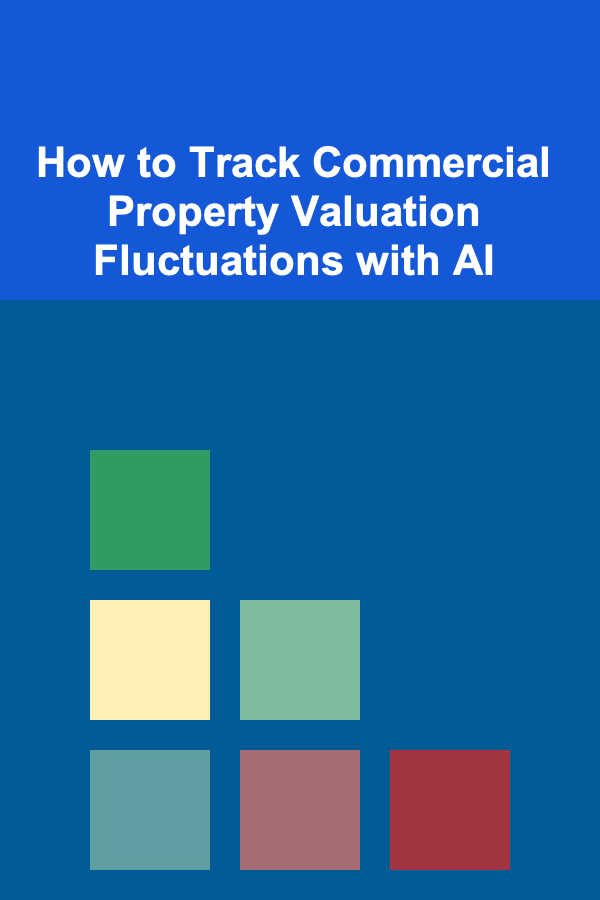
How to Track Commercial Property Valuation Fluctuations with AI
ebook include PDF & Audio bundle (Micro Guide)
$12.99$10.99
Limited Time Offer! Order within the next:

The commercial real estate market is one of the most important sectors in the global economy, with billions of dollars invested every year. Whether for investment purposes, strategic planning, or financial forecasting, understanding and accurately predicting the valuation of commercial properties is crucial. Property valuation, however, is influenced by a wide range of factors that are complex and dynamic. From economic shifts, market trends, and demographic changes to legal and environmental factors, commercial property valuation is never static.
Traditionally, real estate professionals have relied on historical data, comparable sales, and expert appraisals to estimate property values. However, in recent years, advancements in artificial intelligence (AI) have introduced new possibilities for tracking and forecasting commercial property valuation fluctuations with a higher degree of accuracy and efficiency.
In this article, we will explore how AI can be utilized to track fluctuations in commercial property valuations, how AI-driven tools are transforming the real estate industry, and how businesses can leverage these innovations to make more informed decisions.
Understanding Commercial Property Valuation
Before diving into how AI can be used to track valuation fluctuations, it's important to understand the core concepts of commercial property valuation. Property valuation refers to the process of estimating the worth of a property. For commercial properties, the valuation process is influenced by several factors, including:
- Market Trends: These are broad economic conditions that affect the real estate market, such as interest rates, inflation, and overall economic health.
- Location: A property's location is perhaps the most important factor in determining its value. Proximity to infrastructure, commercial hubs, public transport, and amenities plays a significant role.
- Physical Property Condition: The age, size, design, and condition of a building also contribute to its valuation.
- Income Potential: For commercial properties like office buildings, retail centers, and industrial sites, the income generated by leasing or renting out space is a major factor.
- Comparative Sales (Comps): The value of similar properties recently sold in the market is another important benchmark for valuation.
Despite the wide range of influencing factors, traditional methods often rely on human judgment and can be time-consuming, prone to error, and lag behind rapid market changes. This is where AI can make a significant impact.
How AI Tracks Commercial Property Valuation Fluctuations
AI-powered tools and systems can monitor property valuation fluctuations in real-time, taking into account a vast amount of data that would be impossible for humans to process manually. By leveraging machine learning algorithms, natural language processing (NLP), and predictive analytics, AI tools can detect patterns, trends, and anomalies that influence commercial property values.
Here are some key ways in which AI can be utilized to track property valuation fluctuations:
2.1 Predictive Analytics and Machine Learning
Predictive analytics is a form of AI that leverages historical data to forecast future outcomes. In the context of commercial real estate, machine learning models can be trained to analyze factors that influence property valuation, such as market trends, demographic shifts, interest rates, and location-specific data. Once the model is trained, it can predict future property values with high accuracy.
For example, a machine learning model might be trained to recognize how changes in local economic conditions, such as a rise in employment or an increase in business investments, affect the demand for commercial properties. By processing large datasets in real-time, AI can help predict when a property's value will rise or fall, allowing investors and businesses to make more informed decisions.
2.2 Real-Time Data Monitoring
AI-powered platforms can collect and analyze real-time data from a variety of sources, such as property listings, economic reports, transaction data, news articles, and social media. This allows businesses and investors to track valuation fluctuations as they happen.
For instance, AI systems can analyze changes in rental rates, occupancy rates, and sale prices for commercial properties in specific regions. By continuously tracking and analyzing this data, AI systems can quickly identify trends that might indicate a shift in property values.
2.3 Automated Property Valuations (AVMs)
Automated Valuation Models (AVMs) are AI-powered tools that use algorithms to estimate the value of a property. AVMs typically utilize data from multiple sources, including comparable property sales, tax assessments, property characteristics, and more. By analyzing this data, AVMs can generate property valuations without requiring an in-person appraisal.
AVMs are particularly useful for tracking property valuation fluctuations, as they can be updated in real-time based on new data. For example, if a major commercial development project is announced in a neighborhood, the value of surrounding properties may change. An AVM can immediately incorporate this new information and provide an updated valuation.
2.4 Natural Language Processing (NLP) for Market Insights
NLP is a branch of AI that deals with processing and analyzing human language. NLP can be used to scan and analyze news articles, market reports, and even social media for key indicators that may affect commercial property valuations. By extracting meaningful insights from unstructured data, AI systems can identify potential risks and opportunities.
For example, an AI tool might analyze press releases from local governments, business trends, or major infrastructure projects that could influence property values. Additionally, sentiment analysis can be used to gauge public opinion on particular markets, which may signal a shift in property values.
2.5 Geospatial Analysis and AI-Driven Mapping
AI systems can analyze geographic data and create detailed maps that highlight trends in commercial property values. These tools use geospatial analysis to track fluctuations in property values across different regions, neighborhoods, and districts. By combining AI with geographic information system (GIS) technology, businesses can visualize property value trends and pinpoint areas that are likely to experience rapid growth or decline.
For instance, AI-powered geospatial analysis might reveal that commercial properties in one neighborhood are appreciating rapidly due to improved infrastructure, while others in a different area are stagnating due to economic challenges.
Benefits of Using AI for Commercial Property Valuation Tracking
The integration of AI in tracking commercial property valuation fluctuations offers several distinct advantages:
3.1 Enhanced Accuracy and Precision
AI can process vast amounts of data far more quickly and accurately than human analysts. By leveraging machine learning algorithms, AI tools can analyze hundreds or thousands of variables that affect property values, improving the precision of valuations. This results in more reliable data for decision-making and a greater ability to forecast market trends.
3.2 Real-Time Market Monitoring
With AI, property professionals can monitor market changes in real-time. This enables them to react quickly to fluctuations and make informed decisions. Real-time data analysis can give businesses an edge by allowing them to identify emerging trends before they become widely known.
3.3 Cost Savings
AI can automate much of the manual work traditionally involved in property valuation, such as data collection, analysis, and reporting. This automation reduces the need for expensive human resources and minimizes the potential for errors. Additionally, AI systems can operate 24/7, providing continuous monitoring without additional labor costs.
3.4 Predictive Capabilities
AI's predictive capabilities are one of its most powerful aspects. By analyzing past data, AI tools can predict future valuation trends with a high degree of accuracy. This enables businesses to anticipate changes in the market and make proactive decisions. For example, an investor might use AI to predict when a particular property's value will increase or decrease, allowing them to buy or sell at the right time.
3.5 Improved Decision-Making
With AI providing accurate, up-to-date data, businesses can make more informed decisions. Whether it's deciding where to invest, when to buy or sell a property, or how to adjust rental rates, AI offers valuable insights that reduce uncertainty and increase confidence in decision-making.
Challenges and Limitations of Using AI in Commercial Property Valuation
While AI offers numerous benefits for tracking commercial property valuation fluctuations, there are also some challenges and limitations to consider.
4.1 Data Quality and Availability
AI systems rely heavily on data. If the data used to train AI models is incomplete, outdated, or inaccurate, it can lead to flawed predictions and valuations. Access to high-quality, comprehensive data is essential for AI tools to function effectively. In some markets, obtaining reliable data may be difficult or expensive.
4.2 Complexity of Commercial Real Estate Markets
Commercial real estate markets are highly complex and can be influenced by numerous factors, including government policies, local economic conditions, and unforeseen events like natural disasters or pandemics. While AI can analyze a lot of data, it may not always be able to account for sudden or rare events that dramatically affect property values.
4.3 Adoption Barriers
The implementation of AI in the commercial real estate industry may face resistance due to the traditional nature of the industry. Many real estate professionals may be hesitant to rely on AI for decision-making, preferring to use methods they are familiar with. Additionally, the cost of implementing AI-driven tools can be prohibitive for smaller businesses.
Conclusion
AI has the potential to revolutionize how commercial property valuations are tracked and predicted. By using machine learning, predictive analytics, and real-time data analysis, AI tools can provide businesses with deeper insights into market trends and fluctuations. As the technology continues to advance, AI-driven solutions will become more accurate, accessible, and indispensable for property professionals seeking to navigate the complexities of commercial real estate valuation.
While there are challenges to overcome, the benefits of using AI in tracking commercial property valuation fluctuations are clear. By embracing these technologies, businesses can make more informed, data-driven decisions that improve their investment strategies, reduce risks, and ultimately maximize profitability. As AI continues to evolve, it is likely that its role in commercial property valuation will only become more central to the industry's future.
Reading More From Our Other Websites
- [Home Space Saving 101] How to Use Ottoman Storage to Keep Your Space Clutter-Free
- [Home Party Planning 101] How to Keep Your Home Party Organized with a Party Timeline
- [Personal Investment 101] Profiting from AI: Turning Deep Learning into Passive Income
- [Organization Tip 101] What Are the Key Steps to Organizing Your Entryway?
- [Home Cleaning 101] How to Properly Clean and Store Holiday Decorations
- [Sewing Tip 101] Mastering the French Seam: A Step‑by‑Step Guide
- [Personal Investment 101] How to Profit from Deep Learning by Licensing Your Models
- [Home Storage Solution 101] How to Organize Your Digital Storage for a Clutter-Free Life
- [Home Lighting 101] How to Layer Lighting for a Balanced Look in Your Living Room
- [Home Maintenance 101] How to Fix a Running Toilet: A Step-by-Step DIY Guide

How to Clean and Maintain Your Refrigerator to Prevent Breakdowns
Read More
How to Create a Family Command Center for Schedules
Read More
How to Maintain a Minimalist Lifestyle After Decluttering
Read More
How to Make Money Online as a Voice User Interface (VUI) Designer: 10 Actionable Ideas
Read More
How to Organize and Clean Your Office Space at Home
Read More
How to Prepare for the ASCP MLT Exam: A Comprehensive Guide
Read MoreOther Products

How to Clean and Maintain Your Refrigerator to Prevent Breakdowns
Read More
How to Create a Family Command Center for Schedules
Read More
How to Maintain a Minimalist Lifestyle After Decluttering
Read More
How to Make Money Online as a Voice User Interface (VUI) Designer: 10 Actionable Ideas
Read More
How to Organize and Clean Your Office Space at Home
Read More